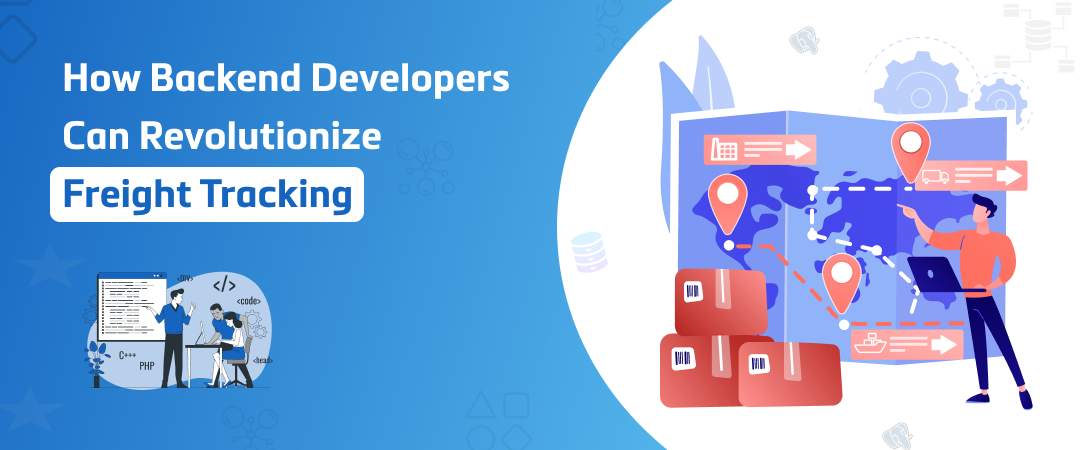
How Backend Developers Can Revolutionize Freight Tracking

We’ve been told for years that logistics processes are ripe for total automation; humans will have their tasks simplified. Yet that still hasn’t happened. What’s stopping the march of technology in this part of the business world?
The threats to the global supply chain are inflation pressures, staff shortages and wars breaking out. This is just the tip of the iceberg. The increasing volatility of global supply chains means that end-to-end visibility carries greater significance than ever.
The disruptions and challenges have made businesses look for ways to build a robust supply chain. Automation is the answer. It promises to help organizations tackle pressing supply chain problems like improving fulfillment quality and safety, maximizing space utilization, and increasing throughput.
Though automation is key to enhancing the shipping and receiving process, more than 80% of warehouses don’t use automation. They continue using manual processes that are time-consuming and prone to errors. Implementing advanced software can reduce manual errors, lower costs, and improve accuracy. These technology solutions automate various shipping processes, such as selecting the most cost-effective carrier, printing shipping labels, and generating tracking numbers.
The Importance of Freight Tracking
Freight tracking offers better visibility into the supply chain which enables shippers to manage inventory, offer status updates, and limit disruptions. As a result, the supply chain will become more agile, improving customer service and controlling costs. Real-time visibility assists in the removal of silos across the supply chain, resulting in lower costs and fewer lost sales.
Shipment tracking and real-time visibility are the key aspects a customer looks for when selecting a freight forwarder. They give a clear picture of the status of the shipment and help to fix unexpected problems before it impacts the delivery time of the shipment.
The example of Pfizer-BioNTech COVID-19 vaccine shipments show how real-time container tracking allows companies to respond better to supply chain issues and disruptions. Vaccines must be stored at a specific temperature during transport. Failing to do it can result in millions of dollars going to waste or inability to deliver the vaccine to people in need. By implementing real-time container tracking solutions, consignors could monitor the temperature conditions of vaccine shipments in real-time and quickly respond when a shipment reaches a temperature that falls outside the acceptable range.
Gone are the days when shipment tracking software primarily focused on basic location tracking. Today, tracking software leverages GPS, RFID, IoT devices, and sensors for precise location tracking, while AI-driven algorithms provide predictive insights and automation for route optimization. Mobile apps and user-friendly interfaces ensure easy access to tracking data.
Get a Free Consultation WhatsApp
Key features in a shipment tracking software
Route optimization: Uses advanced algorithms to understand factors like traffic congestion, road closures, and weather conditions to create the most efficient routes. It aims to minimize travel time, fuel costs, and improve productivity by optimizing the sequence and allocation of destinations in a given route.
Real-time visibility: Improves delivery visibility for the business and the customer. By monitoring and tracking goods in transit, it lets businesses track their shipments, identify delays, optimize routes, forecast demands and enhance operational efficiency. This translates to better decision-making, faster service delivery, and increased customer satisfaction.
Barcode Generation: Creates barcode labels for tracking packages, with essential details such as the order number, seller information, and the buyer’s name, address, and contact information. These barcodes on packages help to eliminate the risk of loss.
Inventory Management: Improves inventory control by providing real-time information on product flow. This helps in monitoring stock levels and anticipating the arrival of new supplies, ensuring restocking on-time and preventing stock shortages or excesses. Real-time tracking can lower inventory shrinkage by up to 12%.
Delivery status updates: Allows businesses and customers to receive notifications about their package’s progress, such as when it’s been shipped, when it’s on the way, and when it’s been delivered. Consignors and consignees can see real-time updates about their package’s status and be aware of delays or issues. This can help businesses take action to resolve any problems and keep customers informed.
Backend Developers Skills in Building an Application
Backend developers play an important role in building a shipment tracking solution, because they are responsible for the server-side logic of the application. Their tasks in software development include
- Database management: Develop and manage a database that has comprehensive information about shipments, ensuring this data is consistently up-to-date and accurate.
- API development: Design APIs that enable the application’s frontend to interact smoothly with the database. These APIs allow the retrieval of shipment data by frontend, update shipment status, and add new shipments.
- System architecture creation: Create a blueprint for system architecture after analyzing the interaction between different components of the application.
- Performance optimization: Optimize the application’s performance enabling it to handle a high volume of users at a time.
- Testing: Thoroughly test the APIs, database, and security measures to ensure all are functioning as expected.
Get a Free Consultation WhatsApp
A freight tracking software is essential for logistics businesses because people want to know where their shipments are. Shipping processes can become unpredictable, and disruptions can happen at any time. Tracking shipments can alleviate worries and allow shippers to prepare contingency plans.
A customized shipment tracking solution is vital to stand out, as well as stay ahead in the competitive market. However, businesses may not have in-house teams with the specific skill sets needed to build a new solution. An off-the-shelf software is a quick and convenient option, but it may not fully meet the requirements of your organization.
The best choice is to hire backend developers who have years of experience in developing customized software solutions. You eliminate the hassles associated with the long process of hiring full-time developers.
If you have decided to hire developers for building freight tracking software for your business, schedule a free consultation with us. We’ll discuss your challenges and create the best possible solution.













